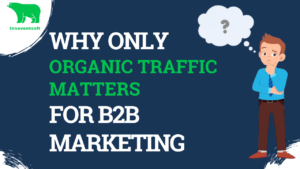All marketing effort translates to a webpage
B2B marketing departments work tirelessly to increase brand awareness, create fresh leads, and enable sales. Some of their activities include:
- Product messaging
- Content creation
- Event participation
- Webinar creation
- Analyst relations
- Digital marketing
- Social media marketing
- Inbound marketing, and the list goes on.
Have you ever wondered, in today’s digital era, if every effort you put in is getting translated into a webpage? This means every step and all your hard work finally takes the shape of a webpage or promotion of a webpage.
Let’s check it by looking at the output of each work:

If you have noticed, the output of every effort is a webpage or the act of promoting it. Hence, it is essential to monitor the performance and effectiveness of each page with respect to organizational goals.
Various Types of Website Traffic to B2B webpages
Based on how your audience reaches your website, we can classify the traffic into direct, referral, and organic traffic.
Direct traffic
The traffic coming straight from typing your website URL is called direct traffic.
Referral traffic
Referral traffic is generated from social media or third-party backlinks.
Organic traffic
Organic traffic represents audiences who reach a website from search engines after searching a query.
Reasons why organic traffic is the best marketing metric for B2B business
Everyone in the top B2B marketing organizations, including CMOs, directors, product marketing managers, and digital marketers, are usually concerned about their website’s organic traffic.
Among the types of traffic you saw above, organic traffic is the best and most accurate B2B marketing traffic representation. Let’s look at why.
3 reasons why direct traffic does not represent your target personas
Since direct traffic represents the traffic coming from typing your website URL, it could likely be any one of the following:
- Audiences clicking on a bookmarked URL of a website from their browser—and any navigation after that will be direct traffic.
- Audience clicking a link in the email or any document (PDF, doc, ppt, etc.) or collaboration apps like Slack, or Skype.
- Website crawlers (:P)
3 reasons why referral traffic is inaccurate
As referral traffic represents audiences mostly from social media or 3rd party backlinks—such as press releases or any marketplaces—it does not accurately define your target personas for three reasons:
- It can be your (X) employees or stakeholders liking and clocking on a post and getting redirected to the website.
- Your promotional or achievement posts or news, such as listing in event participation, analyst papers, information about recent funding, or photos of employee gathering, will not significantly contribute to your consumers’ purchasing decisions, though positively affects the brand. Social posts are perfect for employee engagement and building a positive perception, but they will not directly help win deals.
- Any social media traffic from posts older than three weeks will be useless. Because your target audience is less likely to scan and dig older posts from social media channels like LinkedIn and go to your webpage. (I mean, will you ever do such mining on a vendor’s social media posts?)
Do you see why referring to direct and referral traffic in the B2B tech space is beating a dead horse?
3 reasons why organic traffic is the most accurate representation of B2B marketing traffic
Organic traffic represents the audience who would have come from search engines such as Google or Bing. And these are the three reasons organic marketing is the only significant traffic a B2B marketer should care about:
- Since organic visitors would have searched for a solution to their pain points or searched for topics to get educated (early stages of customer lifecycle journey), they accurately represent your target audience.
- It is possible, though less likely, for your employees or stakeholders to search anything about the pain point and visit your web pages organically; this can only happen when someone is typing the brand on Google instead of the entire website URL.
- Organic search is not just about the audience journey from searching a query on Google to landing on your website. Google also has a huge role to play. Based on the cookies and your search patterns, Google will propose new, and fresh content across its various platforms, such as Google discover, Google stories, etc. And once an audience clicks on a brand’s web page, it is considered an organic search.
Because of the above reasons, we emphasize that organic traffic is the best and most accurate representation of B2B marketing traffic.
Next steps to improve organic traffic
To improve organic traffic, you must constantly create content based on the customer-lifecycle journey, monitor the growth of organic traffic, and its impact on your sales. You can explore Innoventsoft platform, which helps B2B organizations to create the right content for their target audience and improve lead generation.
Also, you may check out the ICM platform to track the metrics live. The platform can be your go-to centralized tool to create a content map and monitor its impact on revenue.





